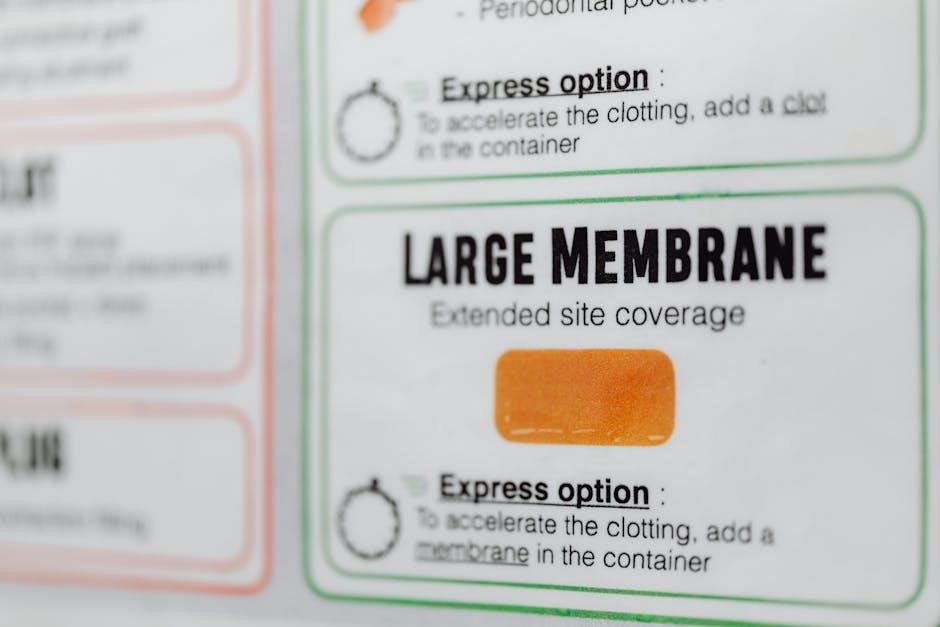
Medical terminology is a specialized language used in healthcare to describe the human body, its functions, and medical procedures. It consists of roots, prefixes, and suffixes that combine to form precise terms. Understanding this system is crucial for clear communication among professionals.
Overview of Medical Terminology

Medical terminology is a specialized language used in the healthcare industry to describe the human body, its functions, and medical conditions. It is designed to provide clear and precise communication among healthcare professionals. This system of terms is built from Greek and Latin roots, combined with prefixes and suffixes, allowing for the creation of thousands of specific words. Understanding medical terminology is essential for anyone working in healthcare, as it facilitates accurate documentation, diagnosis, and treatment.
The terminology is universal, meaning it is understood and used consistently across different countries and medical disciplines. It covers various aspects of healthcare, including anatomy, physiology, diseases, and treatments. By breaking down complex terms into their component parts, learners can decipher meanings and build a strong foundation for further study. This standardized language ensures efficiency and clarity in patient care and professional collaboration.
Medical terminology is not just for doctors and nurses; it is also crucial for students, researchers, and administrators. Its structured approach makes it easier to learn and apply in real-world scenarios. Whether in hospitals, clinics, or laboratories, this language is the backbone of effective healthcare communication.

Key Concepts and Importance

Medical terminology is founded on key concepts that ensure precise communication among healthcare professionals. Its importance lies in its universality, allowing consistent understanding across different medical fields and geographical locations. The ability to convey complex ideas succinctly is vital for accurate patient care, documentation, and research.
The structured nature of medical terms, built from roots, prefixes, and suffixes, enables professionals to decode and construct terms effectively. This system not only enhances clarity but also reduces errors in diagnosis and treatment. For instance, terms like “cardiology” (study of the heart) and “neurology” (study of the nervous system) are instantly recognizable to those familiar with the terminology.
Moreover, medical terminology is essential for maintaining patient records, facilitating insurance claims, and ensuring legal compliance. It serves as a common language, bridging gaps between different healthcare disciplines. Without this standardized system, effective collaboration and patient care would be severely compromised.
Word Parts: Roots, Prefixes, and Suffixes
Medical terminology is built from three primary word parts: roots, prefixes, and suffixes. Roots are the core of medical terms, often derived from Latin or Greek, and represent the main subject or organ (e.g., “card-” for heart). Prefixes, placed at the beginning of a term, modify the root by indicating number, location, direction, or negation (e.g., “sub-” meaning under). Suffixes, added at the end, denote the term’s function, such as a condition, procedure, or disease (e.g., “-itis” for inflammation).
Understanding these components is essential for decoding and constructing medical terms. For example, “cardiology” combines “card-” (heart) with “-logy” (study of), while “arthroscopy” blends “arthr-” (joint) with “-scopy” (examination). Mastery of these word parts simplifies learning and enhances communication in healthcare settings.
Together, roots, prefixes, and suffixes form a logical system that allows healthcare professionals to convey complex ideas precisely. This structured approach ensures clarity and consistency in medical communication, making it a cornerstone of healthcare education and practice.
Common Suffixes in Medical Terms
Suffixes in medical terminology are word parts added to the end of roots or combining forms to modify the meaning of the term. They often indicate a condition, procedure, or disease. Common suffixes include “-itis,” which denotes inflammation (e.g., “arthritis” for joint inflammation), and “-ectomy,” meaning surgical removal (e.g., “appendectomy”).
Other frequently used suffixes are “-ology” (study of, e.g., “pathology”) and “-osis,” which refers to a disease or abnormal condition (e.g., “neurosis”). Suffixes like “-algia” (pain, e.g., “neuralgia”) and “-oma” (tumor, e.g., “carcinoma”) are also prevalent. Understanding these suffixes helps healthcare professionals decode and interpret medical terms accurately.
Mastering common suffixes is essential for effective communication in healthcare settings, enabling professionals to quickly identify the nature of a term and apply it appropriately in diagnosis, treatment, and documentation.
Common Prefixes in Medical Terms
Prefixes are word elements added to the beginning of medical terms to modify their meaning. They often indicate location, direction, or quantity. For example, “hypo-” means under or below, as in “hypoglycemia” (low blood sugar), while “hyper-” denotes above or excess, as seen in “hypertension” (high blood pressure). “Tachy-” refers to speed, as in “tachycardia” (fast heart rate), and “brady-” indicates slowness, as in “bradycardia” (slow heart rate). “Dys-” signifies difficulty or pain, such as in “dyspnea” (difficulty breathing). “Meta-” means beyond or after, as in “metastasis” (spread of cancer), and “epi-” refers to upon or above, as in “epidermis” (outer skin layer). “Endo-” indicates within, as seen in “endocarditis” (heart inflammation). Understanding these prefixes enhances the ability to decode medical terms accurately and communicate effectively in healthcare settings.
Pronunciation of Medical Terms
Pronunciation of medical terms is essential for clear communication in healthcare. Many terms originate from Greek and Latin roots, which influence their pronunciation. Understanding the correct way to say medical words ensures accuracy in clinical settings. For example, “psychiatry” is pronounced as /sɪˈkaɪətri/ (si-KY-uh-tree), where the “p” is silent. Similarly, “obesity” is pronounced as /ˈoʊbəsiːti/ (OH-buh-see-tee), with stress on the second syllable. Common prefixes and suffixes also affect pronunciation, such as “hypo-” (below) in “hypoglycemia” (/ˌhɪpəʊˈɡlaɪˈsiːmiə/). Combining vowels, like “o” in “gastritis” (/ˌɡæstrˈaɪtɪs/), help link word parts smoothly. Practice and repetition are key to mastering pronunciation, especially for complex terms. Resources like medical dictionaries and online audio guides provide clear examples. Accurate pronunciation not only enhances professionalism but also ensures patient safety and effective teamwork in healthcare settings. Consistent practice helps learners confidently communicate medical terminology in real-world scenarios.
Textbooks and Resources for Learning
Mastering medical terminology requires reliable textbooks and resources. Popular textbooks like Quick & Easy Medical Terminology by Peggy C. Leonard offer comprehensive guides, breaking down complex terms into understandable components. Another widely used resource is Medical Terminology for Dummies, which provides a user-friendly approach with exercises and flashcards. These textbooks often include appendices with word parts, abbreviations, and pronunciation guides, making them invaluable for learners. Additionally, many textbooks now come with online companions, offering interactive tools like quizzes and audio pronunciations to enhance learning. For those preferring digital formats, e-books and PDF versions are readily available, ensuring accessibility. These resources emphasize practical application, helping students connect theoretical knowledge to real-world scenarios. By leveraging these textbooks, learners can build a strong foundation in medical terminology, essential for careers in healthcare. Consistent practice with these materials ensures proficiency in understanding and using medical language accurately.
Online Resources and PDF Guides
Online resources and PDF guides have become essential tools for mastering medical terminology. Websites like ICS Learn offer comprehensive PDF guides and sample lessons, providing structured learning materials. Platforms such as Coursera and Udemy feature courses with downloadable PDF resources, combining theoretical knowledge with practical exercises. Additionally, many educational institutions and healthcare organizations publish free PDF guides, covering topics from basic word parts to advanced terminology. These resources often include interactive elements like quizzes, flashcards, and audio pronunciations, making learning engaging and accessible. Popular textbooks, such as Quick & Easy Medical Terminology, are also available in PDF formats, ensuring learners can access them anytime, anywhere. These online resources cater to diverse learning styles, offering flexible and self-paced study options. By leveraging these tools, students and professionals can efficiently gain proficiency in medical terminology, enhancing their communication skills in healthcare settings.
Learning Outcomes and Applications
Mastering medical terminology equips learners with the ability to understand and apply precise language in healthcare settings. Key learning outcomes include identifying and defining word parts (roots, prefixes, suffixes), constructing and deconstructing medical terms, and understanding their meanings. Learners also gain the ability to classify and categorize terms based on body systems and conditions. These skills are invaluable for careers in nursing, medicine, health administration, and medical coding. Applications of medical terminology are vast, ranging from accurate patient documentation to effective communication among healthcare professionals. Proficiency in this field enhances clinical decision-making and ensures clear, concise reporting. Additionally, it aids in understanding medical literature, research, and patient education materials. For students, these skills lay a strong foundation for advanced studies in healthcare. Overall, the knowledge gained from medical terminology is essential for delivering high-quality patient care and advancing in the healthcare industry.